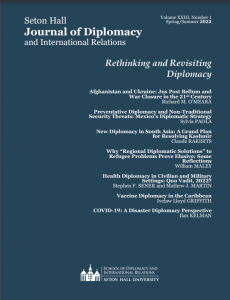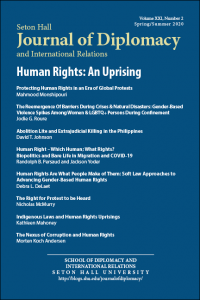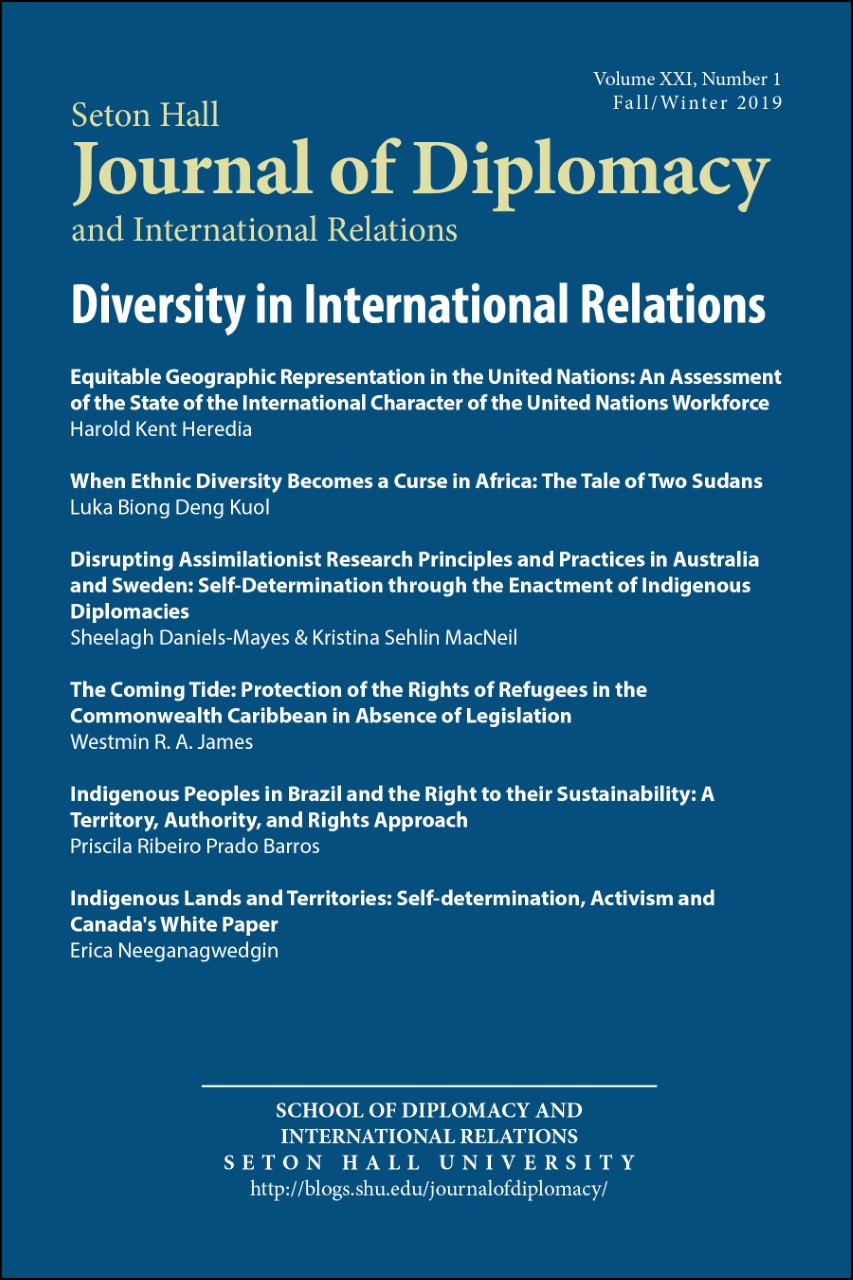Current Issue
Volume XXIII: Spring/Summer 2022
Full Issue PDF: Rethinking & Revisiting Diplomacy Volume XXIII, Number 1
Letter from the Editors
Since the turn of the century, we have seen conflicts emerge, stabilize, and deteriorate as the world has shifted towards a period of post-colonization and globalization. In the past two decades, we have seen the rise, fall, and resurgence of the Taliban in Afghanistan. We have seen the near-century-old conflict in Palestine-Israel and Jammu-Kashmir heighten with civilian lives at stake. Myanmar marched forward with a democratically elected leader yet fell victim to a military coup d’état. The COVID-19 pandemic brought a multitude of conflicts, impacting individual countries and the global world on three levels: political, economic, and social. This global health crisis brought to the forefront a new type of diplomacy: health diplomacy. The current status of these conflicts, amongst others, pushes us to question the traditional nature of diplomacy and understand what must be done to reconfigure diplomacy for the next era.
This year’s issue seeks to serve as a discourse on the failures and the future of diplomacy processes. The twenty-third volume of the Journal contains seven articles on a variety of different conflicts and current diplomacy processes, serving either as case studies or recommendations. The first four articles focus on traditional diplomacy processes and the last four focus on health diplomacy.
Richard M. O’Meara analyzes the cases of wars in Afghanistan and Ukraine, arguing that not only is it crucial for practitioners and scholars to understand the beginning and end of war, but that we they must also understand as well as the conduct of battle. Examining the historical and legal definition of preventative diplomacy, Sylvia Paola evaluates the contemporary approaches and non-traditional security threats to preventative diplomacy, focusing on Mexico’s strategy for preventive diplomacy during its time as a United Nations Security Council member. Alluding to the possibility of peace in the South Asian subcontinent, Claude Rakisits outlines a three-step grand plan to carve the path to a free and demilitarized Jammu and Kashmir. Utilizing a 1½ track dialogue, focusing on the rights of self-determination, Rakisits posits that the resolution of the issue of Jammu and Kashmir, as a result, lead to peace between Pakistan and India. William Maley explores why “regional solutions” to refugee crises, especially in the case of Australia, may not be the answer to solving the refugee problem because of the influence of a state’s domestic politics favoring itself over the good of the people.
When these traditional modes of diplomacy fail, what comes next? As Stephen F. Sener and Matthew J. Martin explore this same question, their answer is: health diplomacy. Focusing on past efforts of health diplomacy, Sener and Martin offer solutions to contribute to global health diplomacy and expand on how this will become a lifeline for state relations. As vaccination continues to be a key driver in the discourse of health diplomacy, Ivelaw Lloyd Griffith studies the gap in vaccine diplomacy dynamics in relation to the power players and the nature of their investment in a combination of humanitarianism and geopolitics. With the diplomatic arena expanding beyond nation-states, it is key to take into consideration the influence of non-state actors such as pharmaceutical companies and multi-lateral organizations. Ilan Kelman examines the potential for health diplomacy during the COVID-19 pandemic from a disaster diplomacy perspective, analyzing its impact on peace, cooperation, and diplomacy between countries. His analysis suggests that while pandemic-related actions may complement existing peace and cooperation efforts, COVID-19 alone is unlikely to lead to new and sustainable diplomatic initiatives for a more peaceful future.
As the world continues to grapple with conflicts, traditional modes of diplomacy are being challenged, and health diplomacy is emerging as a critical element in state relations. The articles presented in this volume provide insights into the complexities of various conflicts and offer recommendations for practitioners and scholars alike. It is clear that diplomacy in the next era must be reconfigured to adapt to the changing global landscape, and health diplomacy must be embraced as a vital component of state relations.
Your Editors
Shivani Shah, Editor-In-Chief
Sohaa Khan, Deputy Editor-In-Chief
Volume XXII: Spring/Summer 2021
Full Issue PDF: The Era of Dis-and-Misinformation Volume XXII, Number 1
Letter from the Editors
As the world continues to recover from the devastating fallout of the COVID-19 pandemic, navigating the harms of misinformation and disinformation remain at the forefront of global conversations on paving the path forward. Preventing the dissemination of false information—particularly during a time where the ways in which we engage with information environments have fundamentally changed—is increasingly complex. Social media platforms have enabled users to not only engage with media but become distributors of it themselves.
When coupled with bad actors, limited repercussions, and poor content regulation, social networks are easily weaponized. At all scales of governance misinformation and disinformation campaigns pose a multidimensional threat. In Myanmar and China, disinformation campaigns were leveraged to target minority groups, while in Central and Eastern Europe, they serve as the cornerstone of destabilizing operations between adversarial states. In yet another facet, countries like Turkey, China, Russia, and Iran have embraced digital authoritarianism and restrict policies on internet accessibility under the pretext of stemming the spread of “fake news.”
This year’s issue seeks to shed light on the nature of these evolving threats from a variety of innovative and understudied perspectives. This issue explores the causes and effects of the spread of misinformation and disinformation throughout different parts of the world and will be timely for years to come given the ever-increasing role and breadth of new technologies infiltrating people’s everyday lives.
Sincerely,
Nicole Kalczynski
Editor-in-Chief
Rebecca Blaser
Deputy Editor-in-Chief
Volume XXI: Spring/Summer 2020
Full Issue PDF: Human Rights An Uprising Volume XXI, Number 2
Letter from the Editor
For centuries, protests have been used to mobilize citizenry in efforts to bring about sweeping change in different parts of the world. Protestors have protested to convey their discontent, to demand a moral response, and to speak truth to power. In 2010, anti government protests in Egypt inspired similar uprisings in other Arab countries, which became known as the Arab Spring. This year, the killings of Ahmaud Arbery, Breonna Taylor, and George Floyd have led people in the US and across the world to march against racism and police brutality. Despite a global pandemic, thousands have taken to the streets to demand justice for Black lives, demonstrating that the principle of equality, a common moral good, is worth risking both health and life.
“Human Rights: An Uprising,” the second issue of our twenty-first volume, sheds light not only on the right to protest itself, but the human rights that have inspired them. Mahmood Monshipouri explores the variations and similarities in contemporary protest while discussing the Black Lives Matter movement. Joudie Roure addresses gender-based violence and LGBTQI rights in Puerto Rico, especially the murder of trans women. Debra DeLaet explains the importance of soft law approaches in making progress toward the realization of gender-based human rights and LGBTQI rights. Randolph Persaud and Jackson Yoder apply the concept of homo sacer to examine differential rights within two key areas: migrants/refugees/asylum seekers in Europe and the effects of COVID-19 on African Americans in the US. Nicholas McMurry argues that the right to be heard is developing in human rights law as expounded in the practice of the UN treaty bodies. Kathleen Mahoney discusses Indigenous rights in Canada. Morten Andersen argues that an investigation of the relationship between corruption and human rights is best viewed as a framework of socially constructed norms, political power, and the complex interrelation of political, legal, economic, and social systems. Finally, David Johnson writes about the origins, causes, and contemporary implications of extrajudicial killings in the Philippines.
This issue sheds light on the strata of protests and human rights. It further affirms the growing political salience of human rights and the power of social movements to overcome the tyranny of exclusion, greed, and special interests which have always undermined them.
Sincerely,
Sushant Naidu
Editor-in-Chief
Volume XXI: Fall/Winter 2019
Full Issue PDF: Diversity in International Relations, Volume XXI, Number 1
Letter from the Editor
Diversity and Inclusion are terms that are commonplace across various industries, including the hiring practices of corporations and in representation at educational institutions. We see diversity and representation play an important role in the democratic nomination race for the 2020 U.S. presidential election, sometimes mentioned only to gain political advantage. Diversity, in terms of whose story gets told and whose doesn’t, is a theme that is woven throughout a variety of global issues, but often takes a backseat to the bigger news stories that tend to dominate media outlets. Yet, diversity or lack thereof is often implicated upon closer examination of global issues.
Climate change, development, violent conflict, terrorism, human rights violations, reform of global governance, and problems of democratic representation throughout the globe are closely tied to issues of diversity. Increasingly, questions of diversity and inclusion present a pathway to solutions to many of these problems. For the 21st volume of the Journal, we wished to showcase and champion diversity and representation in academia by bringing the voices of diverse writers and less familiar topics to our readers.
This issue features three articles on indigenous rights. Sheelagh Daniels-Mayes and Kristina Sehlin MacNeil write on the concept of diplomacy, focusing primarily on the lesser recognized diplomacies of First Peoples in Australia and Sweden. Priscila Ribeiro Prado Barros posits that the growing involvement of Indigenous Peoples in Brazil, in the defense of their own affairs, have triggered the emergence of a new organizing logic, which considers rights as more important than territorial authority. Finally, Erica Neeganagwedgin examines the Canadian federal government’s 1969 Statement of the Government on Indian Policy and the recent Indigenous Rights Framework that the Canadian government introduced in 2018.
The remaining three articles discuss diversity in employment at the UN, the issue of ethnic diversity in the two Sudans, and how international law affects refugees in the Caribbean. Harold Heredia discusses the importance of diversity at the UN as stated in the organization’s charter in Article 101. Luka Kuol examines the case of the two Sudans to argue that ethnic diversity can become a curse when there is a governance deficit that is manifested in social contracts and systems of government that abhor and detest diversity. Westmin James’ article asserts that both international treaty law and customary international law may appropriately aid constitutional interpretation and can protect asylum seekers or refugees from being repatriated to their home country.
Our strong desire to provide a platform for less familiar topics was the driving force behind the creation of this issue. We hope you enjoy this issue and the diverse topics that it touches on.
Sincerely,
Sushant Naidu
Editor-in-Chief




